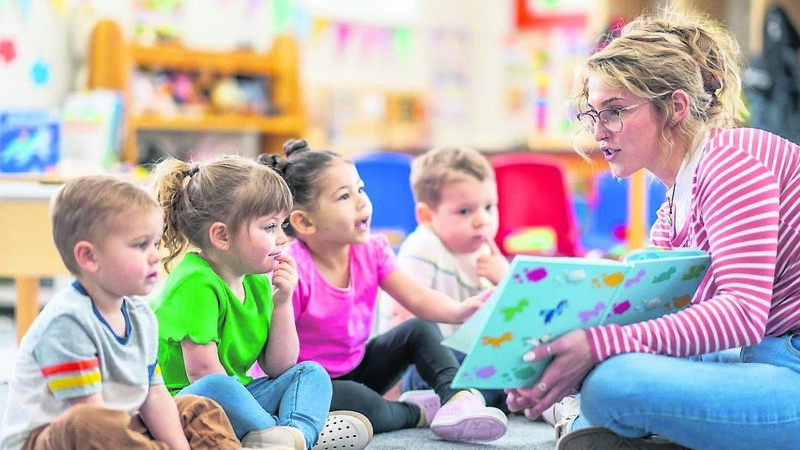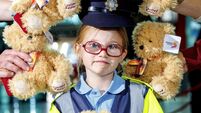Preschool: How to help your child navigate a brave new world

Pre-school is a major transition for children.
“It’s the first significant, consistent separation from the familiar environment out into the wider world and into a structured setting,” says Dolores Wrafter, who leads the Parents First service in Laois/Offaly, which provides support for parents from pregnancy to when their child is three years old.
“Pre-school may be the child’s first time interacting with similar-aged children, particularly if they’re an only child, a first child, or live in a more isolated area,” says Lisa Farrelly, a ParentChild+ national support co-ordinator with the Early Learning Initiative out of National College of Ireland.
Pre-school asks a lot of children, says Teresa Heeney, CEO of Early Childhood Ireland. “It’s a very significant transition that involves adjusting to a new physical environment, different routines, new children, and new group dynamics.
“In terms of social interaction, they have to do loads of things for the first time: Interact with peers, as well as begin to understand children from different family backgrounds than them.”
Heeney points to social skills that pre-schoolers need to develop, from waiting their turn to play with their favourite toy, to sharing and playing together with other children. She also outlines the transition’s emotional challenges: Not just separating from the primary caregiver, but also learning to trust and grow attached to the new adults who will now be part of their lives.
“It’s critical these relationships are made: It’s through secure and nurturing relationships that children learn to grow, learn and thrive,” says Heeney.
Parents can overestimate a child’s readiness for pre-school, says Farrelly. “They might view their child as ready, because they’re not aware of the developmental milestones, or of where their child should be.”
Are they starting to demonstrate independence? Wanting to dress, wash, or feed themselves, asks Farrelly. “They want to make choices around what they want to play with, eat, or wear. They’re becoming a little person.”
Are they beginning to initiate interaction with others, whether adults or children, for example, running up to another child in the playground? “They’re also able to communicate their wants and needs, rather than waiting ‘til Mammy says it’s time to do something.”
Wrafter agrees that showing an interest in social interaction is a positive signal of readiness. “They want to know who’s coming to visit, or who’s who in the extended family. They’re able to cope with short periods of separation from their parent.”
Can your child focus on a task for a short period of time? How are their fine motor skills? Can they hold a crayon? Their cognitive skills: Do they recognise shapes and colours? Are they able to manage emotions, so they’re not having excessive tantrums? If your child is able to manage these elements relatively well, it is a sign they are ready, says Wrafter.
Being curious and interested in new things and in life beyond themselves — playing with new toys and materials, engaging with other children — are all positive signs of readiness, agrees Heeney.
“They need to be able to express their needs and be confident in doing so, as well as understand basic instructions,” she says.
Recommended independence skills include: Being able to eat, dress, and use the toilet with minimal assistance. “Don’t worry if these aren’t fully in place — the pre-school can also help with them.”
Does your child have the physical stamina to participate in pre-school for three hours a day, she asks. “[If not] parents shouldn’t worry if their child gets tired after a couple of hours, because pre-schools will design sessions that balance active outdoor play with more restful indoor activity.”
- Observe, wait, and listen. “Observe your child’s interests. If they’re playing a game, observe and listen to what they’re saying. Extend the conversation a bit more: ‘Oh, I see you’re lining up all your cars. What else can we do? Will we make a bridge?’ Follow your child’s lead on this.”
- Develop your child’s language. Get on their level and use facial expressions, gestures, and body language, as well as words, to help them understand better, says Farrelly. “Saying, ‘You’re lining the pieces up’ gives them language for the activity they’re doing, for their actions. It lets the child feel valued; they’re seen and heard.”
- Remember, children learn through play. “‘Oh, you have the red block on top. I wonder what block you’ll put next? Oh, you’re going for the yellow. So, you’re labelling the colours, their actions, and you’re giving them positional language — on top, underneath, in the middle,” says Farrelly.
- Use the language of emotions to help them identify and understand these, says Farrelly “If they’re building blocks and the blocks fall, you’d say, ‘Aw, I know that was frustrating. That’s OK. What can we do to feel better? Let’s build it again’. So you’re encouraging problem-solving — ‘I wonder why it fell? Do you think it was too tall? Maybe if we made two small towers instead of one big tower?’
- Use books. They are excellent for developing emotional language, says Farrelly. “Where’s Spot? His mum can’t find him. Is he under the bed? I wonder how Spot’s mam is feeling?’ It gives an opportunity to talk about feelings.”
- On a practical level, ensure they have easy-to-remove clothing. “Will they be able to manage their clothing quickly when going to the toilet,” says Farrelly. “Are they able to access their own food and liquids? Let them practise opening and closing containers at home.”
- Find out any rules the pre-school has about the lunchbox, advises Heeney. “This helps children feel like their peers — it reduces anxiety.”
- ”
- Practice separation for short periods, recommends Wrafter. “Doing this regularly gives the message, ‘I will come back’ — the child can trust you will be back, which promotes confidence.”
- Build social skills — having manners, turn-taking, sharing. “They don’t need to be experts the first day — it all comes with time,” says Farrelly.
- Have your child bring a comfort item to keep in their bag, suggests Heeney. “Just knowing a favourite blanket or toy is there can really help.”
- Talk positively about pre-school and reinforce how good this new step is, says Wrafter — ‘you’re going to be building blocks’, or ‘they’ll read your favourite story’.
- Talk to pre-school staff. Build trusting relationships with them and give some background information about your child, such as when their nap and mealtimes are, advises Farrelly. “If your child’s used to a half-hour nap at noon, they could be a bit tired and cranky at that time, especially in the early weeks. So if staff know, they might do [an activity] to get the child over that hump.”
- Ensure staff are aware of the non-verbal ways your child communicates, especially important if there is a language barrier or a developmental delay, says Farrelly. “Maybe pulling at your arms means he’s thirsty. Sharing little cues your child uses will give parents peace of mind.”
- Prepare yourself for this transition, urges Wrafter. “Parents need to navigate their own feelings around the child’s first step into the world. Doing this helps children, who are generally very in tune with their parents’ emotions. Feeling ‘this is a safe place for me to go, and mom or dad know I’m able to do this’ instils confidence.”
- Being on time to collect your child further builds positive feelings about separating. “Knowing you will be there at the end of the time takes away any anxiety they may feel,” says Wrafter.
- Feel your child is not yet ready for a full day of pre-school? Heeney recommends talking with the pre-school so they can tailor a transition for your child.








